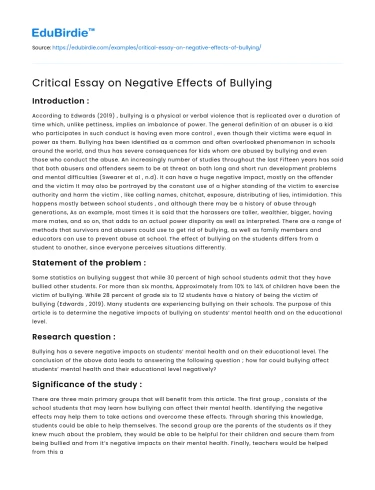Introduction
Bullying, a pervasive issue in educational and social environments, manifests in various forms including physical, verbal, and cyberbullying. It not only affects the immediate victims but also permeates broader societal structures, leading to long-term psychological and emotional consequences. The negative effects of bullying are extensive, influencing mental health, academic performance, and social development. This essay critically examines these adverse impacts, drawing upon specific examples, scholarly research, and real-life cases. The discussion further acknowledges counter-arguments to provide a holistic understanding of the issue. Ultimately, understanding the multifaceted consequences of bullying is crucial for developing effective prevention and intervention strategies.
Psychological and Emotional Consequences
One of the most profound effects of bullying is its impact on the psychological and emotional well-being of individuals. Victims often experience a range of mental health issues, including depression, anxiety, and low self-esteem. A study conducted by the American Psychological Association indicates that individuals who are bullied are at a higher risk of experiencing depression and suicidal ideation (APA, 2017). These psychological effects can persist into adulthood, affecting personal and professional relationships. Real-life cases, such as the tragic story of Phoebe Prince, a high school student who took her own life after relentless bullying, underscore the severe emotional toll bullying can exact.
Save your time!
We can take care of your essay
- Proper editing and formatting
- Free revision, title page, and bibliography
- Flexible prices and money-back guarantee
Furthermore, the emotional scars left by bullying can lead to a cycle of victimization and aggression. According to Bandura's social learning theory, individuals exposed to aggressive behavior may internalize and replicate such actions, potentially becoming bullies themselves (Bandura, 1977). This cyclical nature of bullying exacerbates its impact, creating an environment where aggression is normalized. However, critics argue that not all victims of bullying suffer long-term psychological harm. Some individuals exhibit resilience, suggesting that personal and environmental factors mediate the effects of bullying. Despite this, the overwhelming evidence points to the detrimental impact on the majority of victims.
Impact on Academic Performance
Bullying also significantly affects academic performance, with victims often experiencing declines in academic achievement and school engagement. Research by the National Center for Educational Statistics reveals that students who are frequently bullied have lower academic performance and are more likely to miss school (NCES, 2019). This absenteeism may stem from a desire to avoid hostile environments, leading to gaps in learning and decreased educational attainment. The fear of facing bullies can overshadow a student's focus on academic tasks, resulting in reduced concentration and participation in the classroom.
Moreover, the impact of bullying extends beyond individual academic performance, affecting overall school climate. A hostile environment can disrupt teaching and learning processes, affecting both victims and their peers. Educators face challenges in addressing bullying while maintaining academic standards, as resources are diverted to manage behavioral issues. Critics of the focus on academic consequences argue that bullying's impact on education is overstated, suggesting that other factors, such as socio-economic status, play a more significant role. Nonetheless, the adverse effects of bullying on educational outcomes are well-documented, highlighting the need for comprehensive anti-bullying policies within educational institutions.
Social Development and Interpersonal Relationships
The social development of individuals is another area significantly affected by bullying. Victims often struggle with forming and maintaining healthy interpersonal relationships due to mistrust and fear of rejection. According to a study published in the Journal of Adolescence, individuals who were bullied during childhood exhibit difficulties in establishing social connections in adulthood (Juvonen et al., 2015). This social isolation can lead to long-term consequences, including loneliness and difficulty in collaborative work environments.
In addition, bullying can distort social dynamics within peer groups, creating hierarchies based on power and fear rather than mutual respect and understanding. This environment discourages empathy and cooperation, essential components of effective social interaction. Critics argue that these social consequences are not solely attributable to bullying, as other factors such as family dynamics and cultural influences also play a role. However, the pervasive nature of bullying in formative years significantly contributes to shaping social behavior and attitudes.
Conclusion
In conclusion, the negative effects of bullying are far-reaching, impacting psychological health, academic performance, and social development. The evidence presented highlights the urgent need for effective prevention and intervention strategies to mitigate these consequences. While some individuals may exhibit resilience, the majority of victims suffer long-term harm, underscoring the importance of creating supportive and inclusive environments. Addressing bullying requires a multifaceted approach, involving educators, parents, policymakers, and community members. By fostering empathy and understanding, society can work towards eradicating bullying and promoting mental well-being, educational success, and healthy social development for all individuals.






 Stuck on your essay?
Stuck on your essay?

